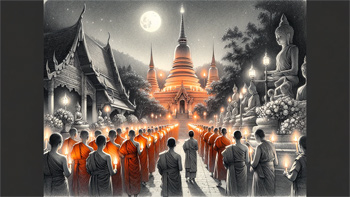Asalha Puja, also known as Dhamma Day, is a pivotal observance in the Buddhist calendar, celebrated with great reverence by Buddhists worldwide. This significant day marks the occasion of the Buddha's first sermon after his enlightenment, known as the "Dhammacakkappavattana Sutta," where he set the "Wheel of Dhamma" in motion. Asalha Puja falls on the full moon day of the eighth lunar month, typically in July, and is followed by the start of the Vassa period, the three-month annual retreat observed by Theravada Buddhists. This article delves into the history, significance, and contemporary observance of Asalha Puja, offering insights into its role in the spiritual life of Buddhists.
The Historical Significance of Asalha Puja
The history of Asalha Puja dates back to the time shortly after the Buddha attained enlightenment under the Bodhi tree. Seeking to share his profound insights, the Buddha chose the full moon of Asalha to deliver his first sermon to his five former companions at the Deer Park in Sarnath, India. This momentous event marked the founding of the Buddhist community (Sangha) and laid down the core teachings of Buddhism: the Four Noble Truths and the Noble Eightfold Path. These teachings provide a framework for understanding the nature of suffering and the path to its cessation, forming the cornerstone of Buddhist philosophy and practice.
Celebrating Asalha Puja
Asalha Puja is celebrated with deep devotion and various religious activities. Temples are adorned with flags and lights, and Buddhists gather to listen to sermons on the Dhammacakkappavattana Sutta. Monks and laypeople partake in chanting, meditation, and offerings. The day is also marked by acts of generosity, such as giving alms, sharing food with monks, and participating in community service. These practices reinforce the principles of giving, morality, and meditation, embodying the essence of the Buddha's teachings.
Asalha Puja and the Vassa Retreat
Following Asalha Puja, the Vassa period begins, lasting for three months during the rainy season. This retreat is a time for intensified meditation and study for monks, and laypeople also increase their focus on spiritual practices. Vassa is an opportunity for both monastic and lay communities to deepen their understanding of the Dhamma and strengthen their commitment to the Buddhist path. The conclusion of Vassa is marked by another important festival, Kathina, which celebrates the communal harmony and spiritual growth achieved during the retreat.
Rituals and Practices on Asalha Puja
Asalha Puja is characterized by specific rituals and practices that reflect the teachings of the Buddha. Circumambulation, walking around a sacred object or place, is a common practice, symbolizing respect and devotion. Candlelit processions are also a prominent feature, illuminating the night and symbolizing the light of the Dhamma dispelling ignorance. Additionally, many Buddhists take the opportunity to reaffirm their commitment to the Five Precepts, the basic ethical guidelines in Buddhism.
Asalha Puja in Different Buddhist Traditions
While Asalha Puja is primarily observed in Theravada Buddhism, its essence resonates across various Buddhist traditions. Each tradition may have unique ways of observing the day, but the underlying focus on the Buddha's first sermon and the principles it introduced remains consistent. The universality of Asalha Puja highlights the shared reverence for the Buddha's teachings among diverse Buddhist communities.
Modern Observances of Asalha Puja
In modern times, Asalha Puja continues to hold great significance. Its observance has adapted to contemporary contexts, with many temples organizing online sermons and virtual gatherings, allowing wider participation. These modern approaches to celebration ensure that the profound teachings of the Buddha remain accessible and relevant to people of all ages and backgrounds in today's fast-paced world.
Asalha Puja's Relevance in Daily Life
Asalha Puja is not just a ceremonial observance but also a reminder of the practical application of the Buddha's teachings in daily life. It encourages Buddhists to reflect on the truths of suffering, its causes, cessation, and the path leading to the end of suffering. By integrating these teachings into their lives, Buddhists strive to cultivate wisdom, ethical conduct, and mental discipline, aiming for personal and collective well-being.
Asalha Puja is a day of great importance in Buddhism, commemorating the Buddha's first teachings that set forth the path to enlightenment. It is a time for reflection, devotion, and reaffirmation of one's commitment to the Buddhist path. As the world changes, the timeless teachings of the Buddha, celebrated on Asalha Puja, continue to offer guidance, hope, and a way to navigate the complexities of life with compassion and wisdom.
